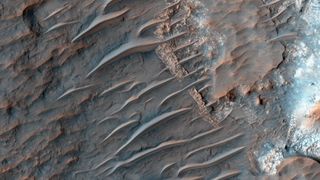Home
News
Spaceflight

An example of transverse aeolian ridges (TARs) in a dune field on Mars, in this case imaged near Syrtis Major by NASA’s Mars Reconnaissance Orbiter.
(Image credit: NASA/JPL–Caltech/University of Arizona)
China’s Zhurong Mars rover has found evidence of a dramatic shift in Mars’ climate 400,000 years ago, in the form of dark ridges laid on top of bright dunes that ripple across the sands of Utopia Planitia, which the rover is exploring.
Scientists led by Li Chunlai from the National Astronomical Observatories of the Chinese Academy of Sciences used the rover’s instruments, coupled with high-resolution observations from China’s Tianwen-1 Mars orbiter, to take a closer look at large sand dunes near where Zhurong landed in May 2021.
The crescent shape of the dunes has been eroded over hundreds of thousand years, with long dark ridges, called transverse aeolian ridges (TARs), forming on top of the dune fields, but apparently at a different angle than that of the wind-blown dunes. TARs have been observed all across Mars at lower mid-latitudes, but global atmospheric circulation models that describe the direction of the winds on the Red Planet have been unable to explain how the features could have formed — until now.
Related: Chinese scientists hold out hope for silent Zhurong Mars rover

How Mars’ winds changed as the ice age came to an end, forming long ridges at a different angle to the dunes. (Image credit: CAS)
Zhurong’s investigation of the dunes found that their crescent-shaped bodies are made of brighter material underneath the darker material that forms the TARs. From orbit, Tianwen-1 observed 2,262 bright dunes across Mars, and based on the number of craters that have impacted on top of the dunes, the research team estimates that they formed between 2.1 million and 400,000 years ago. That means the dark TARs must have formed on top of them within the past 400,000 years.
These dates coincide with the start and end of Mars’ last major ice age. For the TARs to have formed at a different angle to the dunes implies that the wind direction in the lower mid-latitudes must have changed with the end of the ice age.
The ice age began and ended because of changes in the angle at which Mars spins, brought about by Milankovitch cycles. These cycles involve a periodic wandering of a planet’s rotational axis relative to the plane of its orbit, caused by the combined effects of the gravity of the sun, Jupiter and the other planets, as well as the shape and precession of the planet’s orbit.
Both Earth and Mars experience these cycles, which correspond to climatic shifts. In the case of Mars, its angle of rotation (referred to as its obliquity) varied between 15 degrees and 35 degrees between 2.1 million and 400,000 years ago, playing havoc with its climate. Today, Mars’ obliquity is about 25 degrees.
Somewhat surprisingly, an ice age on Mars is not quite the same as on Earth. Typically, Martian ice ages see warmer temperatures at the poles, and movement of water vapor and dust towards the mid-latitudes, where they are deposited. During the last ice age, this water and dust formed a meters-thick layer that still remains beneath the surface in selected locations below 60 degrees latitude, and almost everywhere above 60 degrees.
The current geological era on Mars is known as the Amazonian epoch, which began sometimes between 3.55 and 1.88 billion years ago and is defined by the number of impacts over that time.
“Understanding the Amazonian climate is essential to explain the current Martian landscape, volatile matter reservoirs and atmospheric state, and to relate these current observations and active processes to models of the ancient climate of Mars,” Li said in a statement. “Observations of the current climate of Mars can help refine physical models of Martian climate and landscape evolution, and even form new paradigms.”
Meanwhile, the Zhurong rover entered hibernation during Mars’ long northern winter. It is yet to reactivate, and its fate remains uncertain.
The findings were published onJuly 5 in the journal Nature.
Join our Space Forums to keep talking space on the latest missions, night sky and more! And if you have a news tip, correction or comment, let us know at: [email protected].
Breaking space news, the latest updates on rocket launches, skywatching events and more!
Keith Cooper is a freelance science journalist and editor in the United Kingdom, and has a degree in physics and astrophysics from the University of Manchester. He’s the author of “The Contact Paradox: Challenging Our Assumptions in the Search for Extraterrestrial Intelligence” (Bloomsbury Sigma, 2020) and has written articles on astronomy, space, physics and astrobiology for a multitude of magazines and websites.
>>> Read full article>>>
Copyright for syndicated content belongs to the linked Source : Space.com – https://www.space.com/mars-climate-shift-china-mars-rover-zhurong






























